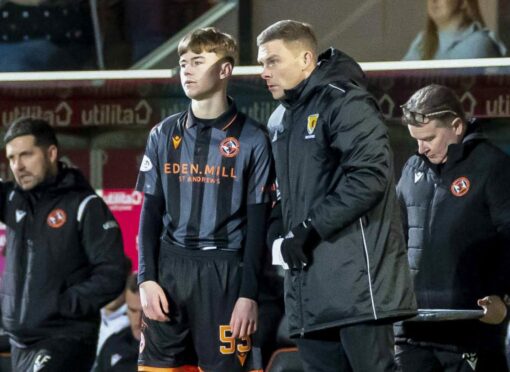
Scottish football might have gained a shiny new record-breaker last Saturday, but for some wayward finishing from the Dundee United forwards at McDiarmid Park.
Had the Tangerines got themselves ahead of 10-man St Johnstone, it is hard to see how manager, Tam Courts, could have resisted the opportunity to give Rory MacLeod a couple of minutes run around.
The striker was 16 years and two days old at the time, and would have become the youngest-ever player to play in the Premiership.
As it was, by the time he made his debut in the win over Motherwell in midweek, he had to settle merely for setting the record for the Tannadice club.
St Mirren’s Dylan Reid pipped him by some 24 hours when he appeared a substitute during a 3-0 defeat from Rangers at Ibrox.
That match is remembered more for Steven Gerrard being spotted hanging out of the home dressing-room window, to acclaim from celebrating, shut-out supporters with the title 24 hours away.
MacLeod got his chance off the back of a scoring run in the Under-18s, no mean feat for a 15-year-old.
As a general rule of thumb, players picked out for such early introductions tend to have something special about them – in terms of skill and physicality, at least.
Whether they have the necessary mentality to cope with all that comes with fame usually takes a bit longer to determine.
When tipping off the Scottish media to the imminent emergence of Wayne Rooney, his Everton team-mate of the time, Scot Gemmill, spoke in awe of a 16-year-old who was so strong, senior pros bounced off him in training.
Christian Dailly, one of MacLeod’s equally-precocious predecessors at Dundee United, was viewed as such a remarkable physical specimen that he was plucked straight out of Sunday boys’ football, and put into the Tangerines first-team when he was 19 days into is 16th year.
Three goals in his early outings paid testimony to the wisdom of Jim McLean’s judgment, something rarely in question when it came to giving youth its fling.
Such was Dailly’s versatility, the legendary Tannadice boss later admitted to being tormented about just where to play him on the park.
If that was the only real grief Dailly gave McLean, he was not so lucky with his other teenage stars.
He thought enough of Dailly and Duncan Ferguson to pair them together in a game against Aberdeen in 1990, a strike force with a combined age of just 36.
In opposition was 31-year-old Alex McLeish.
Yet by the time Ferguson was sold on for £4 million to Rangers, aged 22, stories of his disobedience in the face of the club’s strict disciplinary policy were legion.
He reported back the day after a Christmas night out on crutches, having fallen during the revelry.
And when he and fellow proteges, Andy McLaren and John O’Neil, were ordered to whitewash a gym wall as punishment for a misdemeanour, the result was not a fresh paint job, but a display of offensive graffiti aimed at McLean!
Teenage footballers being unruly is by no means limited to Dundee United, or to Scotland for that matter.
As startling a talent as Rooney was, he has had more than his share of off-field escapades, with his drinking and cheating dealt with in a warts-and-all documentary about the former England star now being screened.
“When you’re in the wrong place, and there’s alcohol involved, you’re gonna make bad decisions,” was his succinct summary of those times.
It is a message delivered with the benefit of hindsight, but no less worth heeding for all young players making the breakthrough.
Where Ferguson and Rooney are two examples of stars who misbehaved, yet enjoyed great careers, there are no end of tales about talents lost to the game as a consequence of drinking, gambling or falling into bad company – sometimes a combination of all three.
It is here a positive role model can make a big difference.
When signing Tony Watt from Motherwell, Tam Courts spoke of the value of getting a player who would be able to pass on the benefit of his experience to the young talent already in the building.
Some experience it is, too.
While the striker famously hit the winner for Celtic against Barcelona aged only 18, in the decade since, he has played for a dozen different clubs.
Not all his moves have gone smoothly.
His old manager at Lierse, Stanley Menzo, memorably commented: “Today I am glad we have Tony. Tomorrow I might want to murder him!”
The midweek “storm-in-a-tea-cup” verbal row with Motherwell chief executive, Alan Burrows, aside, Watt gives every impression of now being a man completely at ease with himself, on and off the park.
That has to be as good an off-field goal for Rory MacLeod to set himself as any.

Enjoy the convenience of having The Sunday Post delivered as a digital ePaper straight to your smartphone, tablet or computer.
Subscribe for only £5.49 a month and enjoy all the benefits of the printed paper as a digital replica.
Subscribe